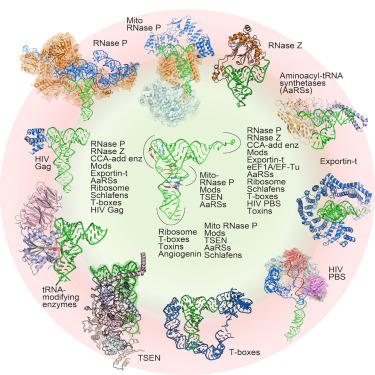当前位置:
X-MOL 学术
›
Cell Chem. Bio.
›
论文详情
Our official English website, www.x-mol.net, welcomes your feedback! (Note: you will need to create a separate account there.)
Recognition of the tRNA structure: Everything everywhere but not all at once
Cell Chemical Biology ( IF 8.6 ) Pub Date : 2023-12-29 , DOI: 10.1016/j.chembiol.2023.12.008 Jinwei Zhang
Cell Chemical Biology ( IF 8.6 ) Pub Date : 2023-12-29 , DOI: 10.1016/j.chembiol.2023.12.008 Jinwei Zhang

|
tRNAs are among the most abundant and essential biomolecules in cells. These spontaneously folding, extensively structured yet conformationally flexible anionic polymers literally bridge the worlds of RNAs and proteins, and serve as Rosetta stones that decipher and interpret the genetic code. Their ubiquitous presence, functional irreplaceability, and privileged access to cellular compartments and ribosomes render them prime targets for both endogenous regulation and exogenous manipulation. There is essentially no part of the tRNA that is not touched by another interaction partner, either as programmed or imposed by an external adversary. Recent progresses in genetic, biochemical, and structural analyses of the tRNA interactome produced a wealth of new knowledge into their interaction networks, regulatory functions, and molecular interfaces. In this review, I describe and illustrate the general principles of tRNA recognition by proteins and other RNAs, and discuss the underlying molecular mechanisms that deliver affinity, specificity, and functional competency.
中文翻译:

tRNA 结构的识别:无处不在但不是同时识别
tRNA 是细胞中最丰富、最重要的生物分子之一。这些自发折叠、结构广泛但构象灵活的阴离子聚合物确实架起了RNA和蛋白质世界的桥梁,并充当破译和解释遗传密码的罗塞塔石碑。它们的普遍存在、功能上的不可替代性以及进入细胞区室和核糖体的特权使它们成为内源性调节和外源性操作的主要目标。tRNA 基本上没有任何部分不被另一个相互作用伙伴接触,无论是按照编程还是由外部对手强加。tRNA 相互作用组的遗传、生化和结构分析的最新进展产生了关于其相互作用网络、调节功能和分子界面的大量新知识。在这篇综述中,我描述并说明了蛋白质和其他 RNA 识别 tRNA 的一般原理,并讨论了提供亲和力、特异性和功能能力的潜在分子机制。
更新日期:2023-12-29
中文翻译:

tRNA 结构的识别:无处不在但不是同时识别
tRNA 是细胞中最丰富、最重要的生物分子之一。这些自发折叠、结构广泛但构象灵活的阴离子聚合物确实架起了RNA和蛋白质世界的桥梁,并充当破译和解释遗传密码的罗塞塔石碑。它们的普遍存在、功能上的不可替代性以及进入细胞区室和核糖体的特权使它们成为内源性调节和外源性操作的主要目标。tRNA 基本上没有任何部分不被另一个相互作用伙伴接触,无论是按照编程还是由外部对手强加。tRNA 相互作用组的遗传、生化和结构分析的最新进展产生了关于其相互作用网络、调节功能和分子界面的大量新知识。在这篇综述中,我描述并说明了蛋白质和其他 RNA 识别 tRNA 的一般原理,并讨论了提供亲和力、特异性和功能能力的潜在分子机制。



























 京公网安备 11010802027423号
京公网安备 11010802027423号